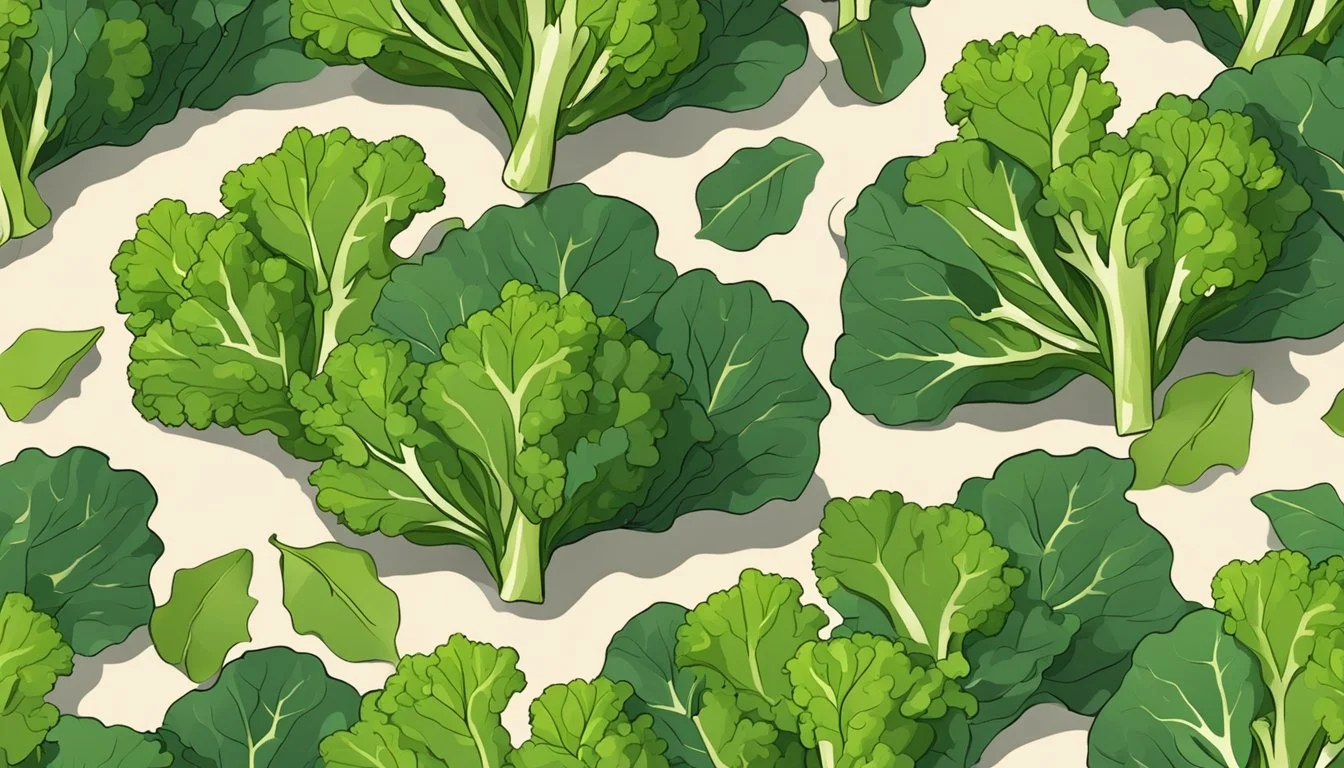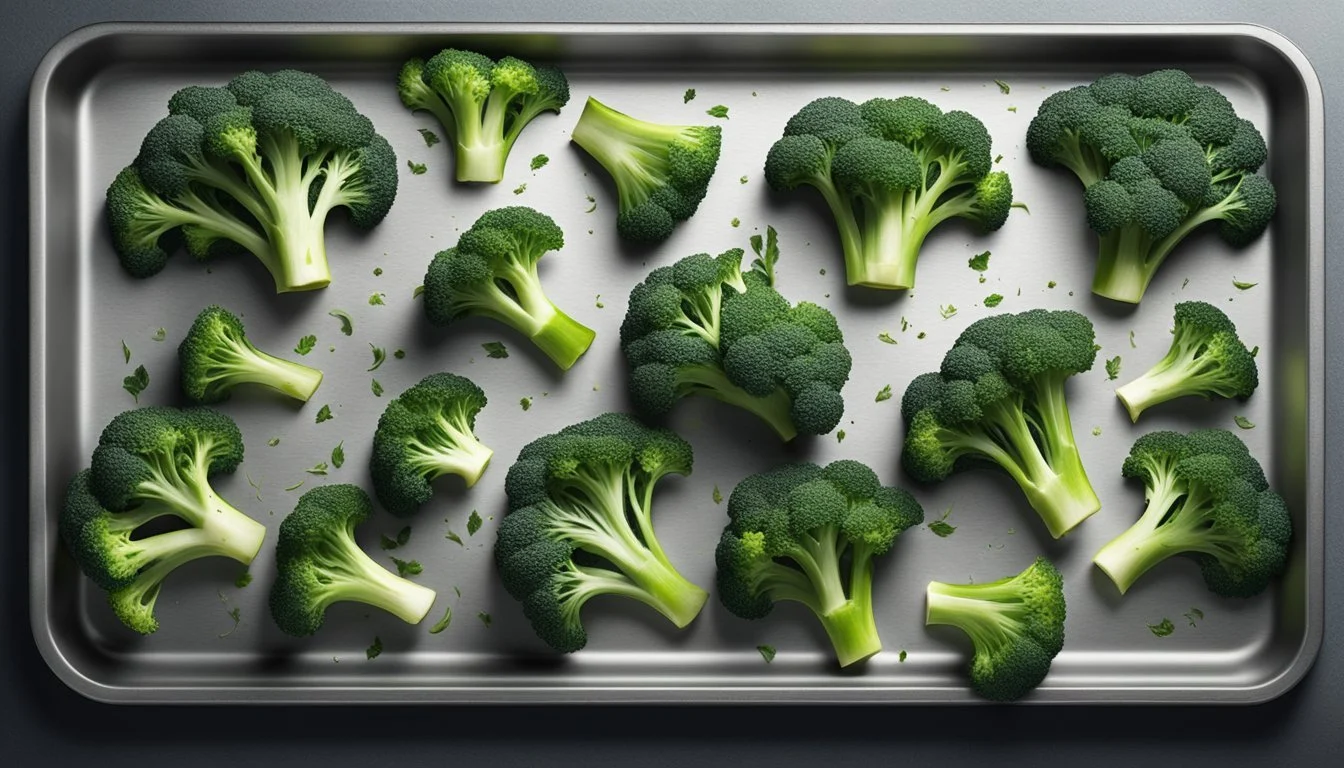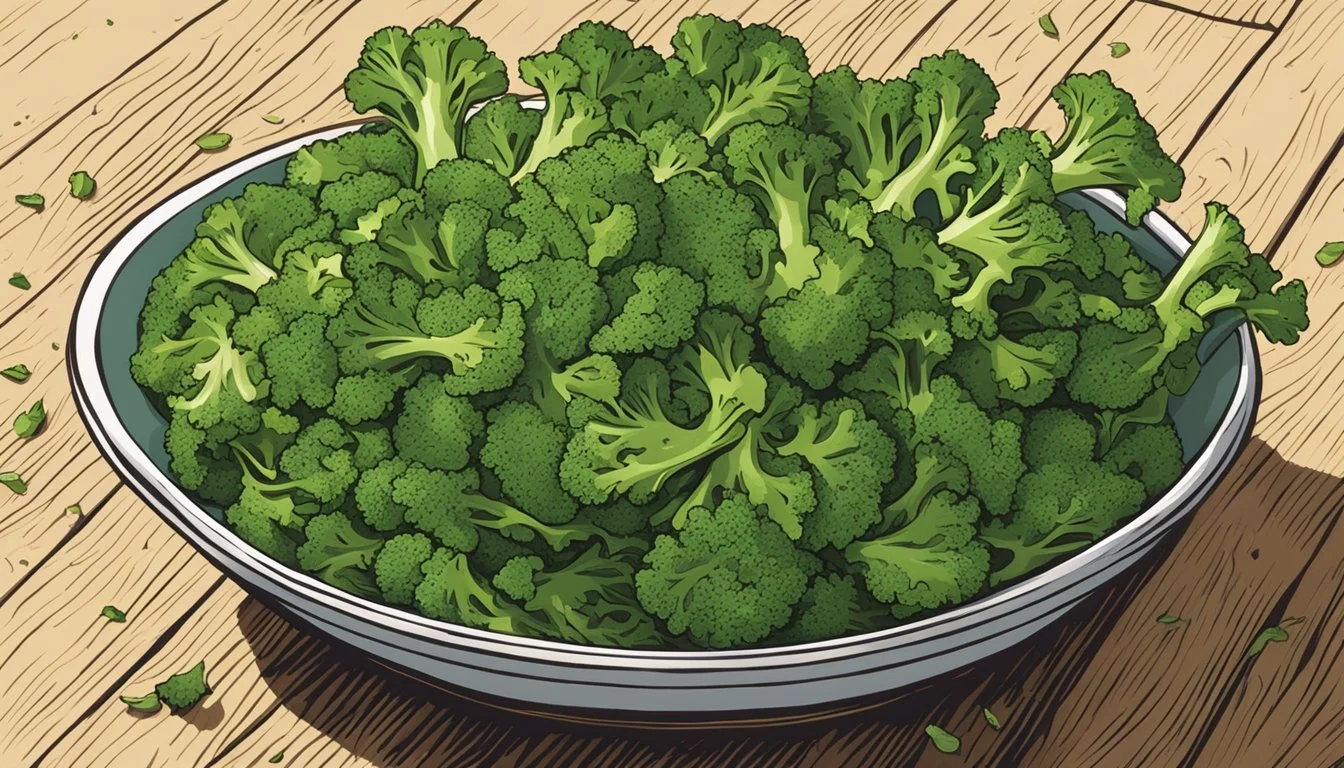Broccoli Leaf Chips
Discover a Nutritious Twist on Crunchy Snacks
Broccoli leaves, often overlooked and discarded, are the unsung heroes of the vegetable world. Rich in vitamins, minerals, and dietary fiber, these robust leaves offer a unique opportunity for a nutritious twist on traditional vegetable chips. Capitalizing on the rising trend of healthy snacks, broccoli leaf chips stand out as a tantalizing option, providing a satisfying crunch and a powerhouse of nutrients.
The process of making broccoli leaf chips is delightfully straightforward, allowing the natural flavors of the vegetable to shine through. After selecting fresh broccoli leaves, a quick wash and pat dry prepares them for a light coating of oil and seasoning. Baked to a perfect crisp, these chips become an appealing snack that rivals the alluring taste and texture of potato chips, but with the added benefits of broccoli's healthful profile.
By turning to this novel use of broccoli leaves, snack enthusiasts and health-conscious consumers can reduce food waste while indulging in a guilt-free treat. Broccoli leaf chips offer a new perspective on snacking, highlighting the potential of this green vegetable in ways that extend beyond the traditional florets and stalks. Whether enjoyed as a solitary snack or as a crunchy addition to meals, broccoli leaf chips are set to become a distinguished facet of the health-oriented snack market.
Nutritional Profile of Broccoli Leaves
Broccoli leaves are a powerhouse of nutrients, offering a diverse range of vitamins and minerals essential for maintaining good health. These leaves are not only versatile for cooking but are also a great addition to a healthy diet when transformed into crispy snacks.
Vitamins and Minerals in Broccoli Leaves
Broccoli leaves are abundant with vitamin C, providing about 93 mg per 100 grams. They are also a good source of vitamin K, crucial for blood clotting and bone health. Other vitamins present are vitamin A, which is vital for eye health, and folate, beneficial for DNA synthesis and repair.
The mineral content of broccoli leaves is significant as well, with calcium (47 mg/100 grams) for strong bones and teeth, magnesium (25 mg/100 grams) for regulating muscle and nerve functions, and potassium for maintaining normal blood pressure levels. They are also a source of iron, which is necessary for transporting oxygen throughout the body.
Vitamin C: 93 mg/100 g
Vitamin A: Good source
Folate: 72 µg/100 g
Calcium: 47 mg/100 g
Magnesium: 25 mg/100 g
Iron: Contains
Macronutrient Composition
In terms of macronutrients, broccoli leaves contain a balance of fiber, protein, and carbohydrates. The fiber, especially the presence of soluble fiber, can aid in lowering blood sugar levels and improving heart health by reducing cholesterol. The protein content contributes to muscle repair and growth, while the carbohydrates provide energy. They are low in sugar which makes them suitable for people monitoring their blood sugar levels.
Fiber: High in soluble fiber
Protein: Present
Carbohydrates: Mainly complex carbs
Sugar: Low
Health Benefits of Broccoli Leaves
Broccoli leaves contain antioxidants that can help reduce oxidative stress in the body and may play a role in cancer prevention. The high levels of vitamin C and beta-carotene (a precursor to vitamin A) have anti-inflammatory properties which are beneficial for heart health. Additionally, a diet rich in folate from broccoli leaves can contribute to heart disease prevention. The omega-3 fatty acids present have shown benefits for heart health as well, complementing the anti-inflammatory and antioxidant effects.
Antioxidants: High levels, may aid in cancer prevention
Anti-inflammatory: Contains vitamin C and beta-carotene
Heart Health: Folate and omega-3 fatty acids beneficial
Blood Pressure: Potassium can help regulate
Culinary Uses of Broccoli Leaves
Broccoli leaves offer versatility in the kitchen, standing out for their nutritional value and their ability to enrich a variety of dishes with their distinctive flavor and texture.
Comparison With Similar Foods
Broccoli leaves are part of the cruciferous vegetable family, sharing nutritional similarities with kale, spinach, and cauliflower. They contain a rich concentration of vitamins, surpassing the vitamin A content found in similar vegetables, an essential nutrient that supports eye health and immunity. When compared to spinach or kale, broccoli leaves present a more robust flavor and a heartier texture, which holds up well in cooking.
Kale: A well-known leafy green, sturdy, slightly bitter.
Spinach: Tender, wilts quickly when cooked, mild flavor.
Broccoli Leaves: Robust flavor, hearty texture, highly nutritious.
Incorporating Broccoli Leaves into Meals
Broccoli leaves can be a great addition to various meals. In salads, they add a crisp texture and can be balanced with sweeter vegetables like sweet potato or complemented by creamy elements such as hummus or a rich dressing. When making a side dish, one may sauté broccoli leaves with garlic and olive oil or incorporate them into stir-fries alongside other vegetables. Due to their substantial texture, they retain their integrity better than spinach when exposed to heat.
Salads: Combine with sweet potatoes, nuts, or hummus for a nutritious dish.
Sautés: Garlic and olive oil enhance their hearty taste.
Stir-fries: Sauté with a mixture of colorful vegetables for a filling side.
Creative Recipes for Broccoli Leaf Chips
Broccoli leaf chips provide a healthy snack alternative, rich in vitamins and flavor. Here's a simplified recipe card crafted to help create this snack:
Ingredients: Broccoli leaves, olive oil, garlic powder, salt.
Instructions:
Step Action 1. Preheat the oven to 350°F (176°C). 2. Toss broccoli leaves in olive oil and garlic powder. 3. Lay the leaves on a baking sheet, ensuring they don't overlap. 4. Season with salt to taste. 5. Bake for 10-12 minutes until crisp.
The final outcome should be crispy and golden, a testament to the versatility of broccoli leaves as more than just a side dish but also a stand-alone snack.
Preparation and Cooking Tips
To ensure a delicious outcome for Broccoli Leaf Chips, attention must be given to the proper selection, storage, and preparation methods. Utilizing the right flavors can elevate this snack from good to great.
Selecting and Storing Broccoli Leaves
Selection: Look for fresh broccoli leaves that are vibrant in color without any yellowing or bruising. Fresh leaves will yield the best flavor and texture when roasted.
Storage: Store unwashed leaves in the refrigerator in a loose plastic bag with a paper towel to absorb excess moisture. Fresh leaves can last up to a week; however, for extended storage, blanch and freeze them.
Optimal Cooking Methods
Baking: Preheat your oven to 375°F (190°C) for a balanced roast.
Roasting: Spread the leaves in a single layer on a baking sheet lined with parchment paper, ensuring they're dry to avoid sogginess.
Timespan: Bake for 10-12 minutes or until the edges are crisp and lightly browned, flipping halfway through for an even crispiness.
Flavor Enhancements
To add a punch of flavor, incorporate these ingredients to the leaves before baking:
Ingredient Quantity Purpose Olive oil 1 tablespoon For crispiness and rich flavor Salt ½ teaspoon To enhance the overall taste Lemon juice 1 teaspoon Adds a bright, citrus note Garlic 1 clove, minced Provides a savory depth Cumin ¼ teaspoon, ground Gives a warm, earthy spice to the chips
The broccoli leaves should be evenly coated with olive oil and the seasonings listed for uniform flavor and texture.
Dietary Considerations and Restrictions
When making broccoli leaf chips, one should be mindful that they can cater to a wide array of dietary needs, providing a snack that's low in calories and fat, rich in nutrients, and easily adapted for various diets, including vegan, gluten-free, and dairy-free plans.
Low-Calorie and Low-Fat Options
Broccoli leaf chips present a snack opportunity that is inherently low in calories and almost fat-free, making it an excellent choice for individuals counting calories or seeking a low-fat diet. Unlike potato chips, which are high in unsaturated fats and calories, broccoli leaf chips can be baked with minimal oil or seasonings to maintain their nutrient-dense nature. A sprinkle of herbs and spices can enhance their flavor without adding substantial calories.
Low-Calorie Flavoring Options:
Herbs: basil, parsley, thyme
Spices: paprika, garlic powder, black pepper
Adapting Recipes for Special Diets
Broccoli leaf chips are versatile and can easily comply with special dietary restrictions. For vegans, they are a natural fit, as plants are the core of vegan diets. Those who require a gluten-free or dairy-free diet can enjoy broccoli leaf chips without modification, as they are naturally free from gluten and dairy. However, care should be taken with store-bought seasonings or dips to ensure they also meet these requirements.
Special Diet Adaptations:
Vegan: Use nutritional yeast instead of Parmesan for a cheesy flavor.
Gluten-Free: Verify that any packaged seasonings are certified gluten-free.
Dairy-Free: Opt for dairy-free dips or dressings if serving with accompaniments.
Broccoli Leaves and Overall Health
Broccoli leaves, often overlooked in favor of their floret counterparts, are rich in nutrients beneficial for overall health. They play a vital role not only as part of a healthy diet but also in the prevention and management of chronic diseases.
Impact on Chronic Diseases
Chronic diseases such as cancer, heart health, and type 2 diabetes are major health concerns. Studies suggest that a diet high in leafy greens like broccoli leaves can reduce the risk of these conditions. Broccoli leaves are high in compounds with anti-inflammatory and antioxidant properties, essential in cancer prevention. Their fiber content aids in cholesterol management, crucial for heart health.
Type 2 Diabetes: Broccoli leaves help in regulating blood sugar levels due to their fiber content.
Blood Pressure: The potassium in broccoli leaves can help maintain healthy blood pressure levels.
Heart Health: The vitamins, minerals, and antioxidants in broccoli leaves support heart health by reducing arterial plaque and lowering the risk of coronary diseases.
Supporting a Healthy Lifestyle
Incorporating broccoli leaves into a diet is a strategic choice for those aiming for a healthier lifestyle.
Healthy Diet: They offer a potent mix of vitamins, minerals, and antioxidants, with a significant amount of vitamin C and vitamin A.
Plant-Based Protein: For those seeking alternatives to animal protein, broccoli leaves provide a valuable source of plant-based protein.
Healthy Fats: While broccoli leaves themselves are low in fat, they pair well with healthy fats such as olive oil to enhance flavor and nutrient absorption.
Natural Sweetness: When cooked, they can develop a subtle, natural sweetness, which can help satisfy cravings for less healthy sweet snacks.
Regular consumption of broccoli leaves can be a key component of a balanced diet, contributing to overall well-being and the management of chronic health issues.
Safety and Allergies
When preparing broccoli leaf chips, it’s important to consider both safety in terms of possible interactions with medications, and the potential for food allergies. Broccoli leaves contain various compounds that can affect individuals differently, especially those on certain medications or with specific allergies.
Possible Interactions with Medications
Broccoli leaves are high in vitamin K, which plays a key role in blood clotting. Individuals taking blood-thinning medication, such as warfarin, should monitor their vitamin K intake to maintain consistent levels. Sudden changes in the consumption of vitamin K-rich foods could alter the effectiveness of these medications. In addition to vitamin K, broccoli leaves contain compounds like glucosinolate and sulforaphane, which are beneficial but might interact with certain drugs. Here's a brief overview:
Compound Potential Interaction Vitamin K Can affect blood clotting, careful management needed if on blood-thinning medication. Glucosinolates Can affect drug metabolism, consult with a healthcare provider. Sulforaphane Could potentially interact with medications; further research is warranted.
Identifying and Managing Food Allergies
Broccoli is not commonly associated with food allergies, but it’s still possible for individuals to be allergic to any food, including broccoli. Symptoms of a broccoli allergy might include itching, swelling, difficulty breathing, or gastrointestinal distress. If a person suspects an allergy to broccoli leaves, they should consult an allergist for testing and diagnosis. It is important to note that broccoli, including its leaves, is naturally low in sodium, making it a healthy option for those managing sodium intake for health reasons. However, seasoning added to broccoli leaf chips could contribute additional sodium, so it's advisable to use herbs and spices for flavor if sodium consumption is a concern.
Sustainability and Environmental Impact
Broccoli leaf chips are an innovative way to embrace sustainability and reduce environmental impact. The key benefits include promoting home gardening and diverting edible greens from the waste stream.
Growing Broccoli Leaves at Home
Homegrown broccoli provides a two-fold sustainability advantage: it supports organic farming and encourages sustainable practices. Gardening enthusiasts can grow broccoli and use both the leaves and florets, maximizing the yield from each plant. By growing broccoli at home, individuals can reduce their carbon footprint stemming from the transportation of food items. Additionally, home gardening fosters soil enrichment and healthy ecosystems when integrated with organic farming methods, such as the avoidance of synthetic pesticides and fertilizers.
Benefits of Growing Broccoli at Home - Reduces transportation-related emissions - Fortifies and enriches garden soil - Promotes biodiversity and supports pollinators - Facilitates organic and pesticide-free growth
Broccoli Leaves and Food Waste Reduction
Broccoli leaves often end up as food waste or in composting bins; however, they are highly nutritious and edible. Utilizing these leaves for human consumption directly combats food waste. When consumers make broccoli leaf chips, they are participating in a form of sustainable practice by making use of food parts typically discarded. Such practices can significantly ease the burden on landfills and reduce methane emissions from decomposing organic matter. Furthermore, adopting these habits complements food waste reduction strategies at both the consumer and commercial levels.
Steps to Reduce Food Waste with Broccoli Leaves 1. Harvest broccoli leaves along with the florets. 2. Transform the leaves into nutritious snacks like chips. 3. Include leaves in other recipes to fully utilize the entire plant. 4. Teach others about the edibility and versatility of broccoli leaves.
By incorporating broccoli leaves into the everyday diet through simple and delicious preparations like chips, it reinforces the value of sustainability and lessens the environmental burden of food production and waste.









